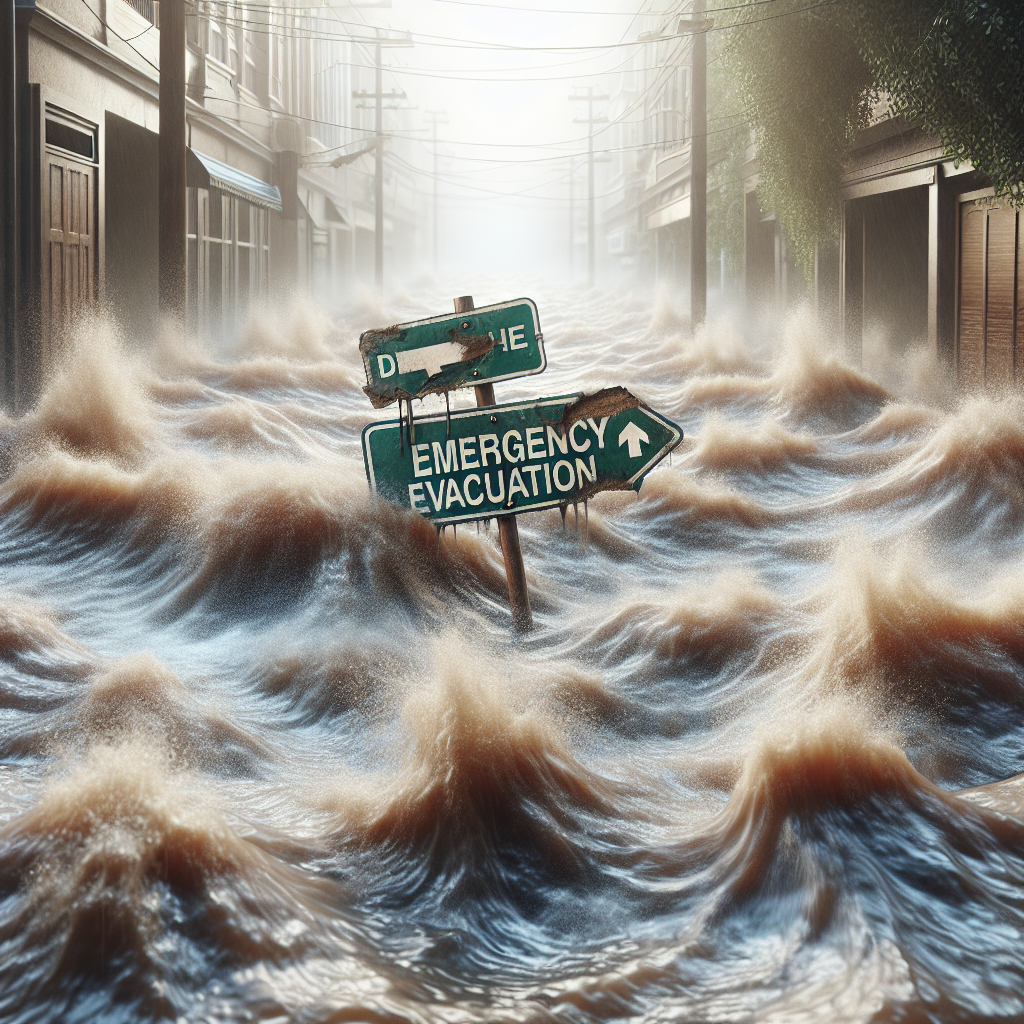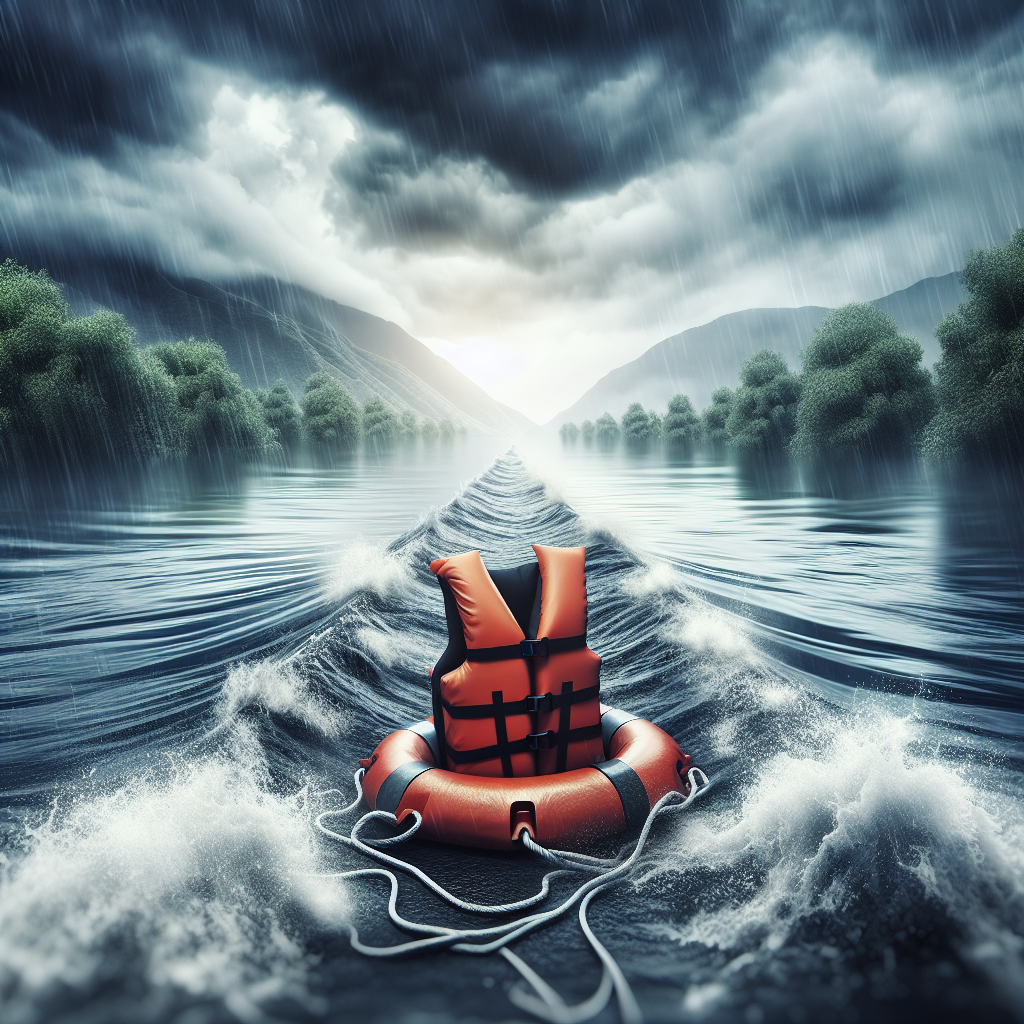During a flood emergency, it’s crucial to stay calm and take immediate action to ensure your safety. Whether you find yourself faced with rising waters or the aftermath of a devastating flood, knowing what to do can make all the difference. In this article, we will explore practical steps you can take to protect yourself, your loved ones, and your property during a flood emergency. From preparing an emergency kit to understanding evacuation procedures, we’ve got you covered with essential tips and guidance to help you navigate this challenging situation with confidence. So, keep reading to equip yourself with the knowledge and resources necessary to effectively respond to a flood emergency.
Preparation before a flood

Create an emergency plan
Before a flood occurs, it is crucial to have an emergency plan in place. This includes discussing evacuation routes with your family and determining where to meet if you get separated. Assign responsibilities to each family member, such as grabbing important documents or packing the emergency kit. By creating this plan ahead of time, you will be better prepared to act quickly and stay safe during a flood.
Prepare an emergency kit
Having an emergency kit ready can make a significant difference in times of crisis. Your kit should include essential items such as non-perishable food, water, flashlights, batteries, a first aid kit, medication, hygiene products, extra clothes, a battery-powered radio, and any necessary personal items. Store the kit in a waterproof container in an easily accessible location, ensuring that every family member knows its whereabouts.
Secure important documents and valuables
To protect your valuable possessions and essential documents, it is wise to secure them in a safe and easily accessible place. Consider investing in a waterproof and fireproof safe or using a safety deposit box at your local bank. Important documents may include identification documents, insurance policies, birth certificates, marriage certificates, and other legal or financial records.
Familiarize yourself with evacuation routes
In the event of a flood, it is vital to know the evacuation routes in your area. Contact your local emergency management agency or research online to understand the evacuation procedures specific to your community. Familiarize yourself with the designated safe shelters or assembly points and the best routes to get there. This knowledge will help you stay calm and navigate to safety efficiently.
Stay informed about flood warnings
Keeping yourself informed about flood warnings is crucial during a flood emergency. Pay attention to local news, weather updates, and emergency alerts through radio, television, or smartphone apps. Follow official social media pages of local government authorities or emergency management agencies for the latest information. Staying informed will allow you to make informed decisions and take necessary actions to protect yourself and your loved ones.
During a flood
Ensure personal safety
In the midst of a flood, it is of utmost importance to prioritize personal safety. Avoid putting yourself at risk by staying away from floodwaters, both on foot and while driving. If water levels are rising rapidly or you are in immediate danger, evacuate to higher ground as soon as possible. Do not attempt to traverse flooded roads, as they may be deeper or more treacherous than they appear.
Evacuate if instructed
If local authorities issue an evacuation order, it is crucial to comply immediately. Follow their instructions and guidelines to ensure your safety and the safety of those around you. Grab your emergency kit, essential documents, and any necessary medication before leaving your home. If time permits, inform a trusted neighbor or family member about your evacuation and provide them with your contact information.
Avoid walking or driving through floodwaters
One of the most dangerous mistakes during a flood emergency is attempting to walk or drive through floodwaters. It only takes a few inches of moving water to sweep you off your feet or carry your vehicle away. The water may also be contaminated or hiding dangerous debris and submerged obstacles. It is best to wait for the water to recede before attempting to cross affected areas.
Turn off utilities
To prevent further damage or potential hazards, it is essential to turn off your utilities during a flood. Shut off the main electrical breaker if instructed to do so by local authorities or if you believe your home is at risk. Turn off the gas supply to avoid potential leaks or explosions. Additionally, shut off the water supply if there is a risk of contamination or if flooding is imminent.
Move to higher ground
If you are unable to evacuate or are advised to stay at home, move to higher ground within your residence. Seek refuge on the upper floors and take necessary precautions to protect yourself from rising water levels. If your home does not have multiple levels, seek high ground such as a rooftop or climb onto sturdy furniture. Remember to bring your emergency kit and personal belongings with you.
Managing water inside your home
Shut off electricity
If your home starts to flood and there is a likelihood of water coming into contact with electrical outlets or appliances, it is crucial to shut off the electricity supply. This will help prevent electric shocks and potential fires. Locate your main electrical breaker and turn it off to cut off power to the house. If you are unsure of how to do this safely, contact a professional electrician for assistance.
Avoid contact with floodwater
Floodwater can pose significant health risks due to contamination from sewage, chemicals, and other hazardous substances. It is crucial to avoid direct contact with floodwater as much as possible. If you must enter the water, always wear protective gear such as gloves, rubber boots, and waterproof clothing. However, it is best to minimize exposure and seek professional assistance for any necessary tasks.
Move belongings to higher areas
If you have advanced warning of a flood, try to move your belongings to higher areas of your home. This may involve relocating furniture, valuables, electronics, and sentimental items to upper floors or elevating them on sturdy shelves or platforms. By keeping your possessions above the anticipated water levels, you can reduce the likelihood of damage and save items from potential destruction.
Use sandbags and barriers
Sandbags can be an effective tool for redirecting water flow and protecting vulnerable areas of your home. Place sandbags strategically around doorways, windows, and other openings prone to water penetration. Stack the sandbags in a brick-like pattern, ensuring each bag overlaps the previous layer for a tight seal. If available, consider using other flood barriers such as flood gates or water-filled barriers for added protection.

Monitor water levels
During the flood, it is crucial to continuously monitor the water levels both inside and outside your home. Pay attention to any signs of rising water, leaks, or structural damage. Listen to updates from local authorities and follow their advice regarding evacuation or further actions. Staying vigilant and proactive will help you respond effectively to any changes in the flood situation.
Safety precautions
Avoid wading in floodwaters
During a flood, it is essential to avoid wading in floodwaters whenever possible. The water may be contaminated with sewage, chemicals, or other harmful substances. Additionally, submerged objects and debris can pose hidden dangers. If you must enter the water for any reason, always wear protective gear, including waterproof boots and gloves. Minimize exposure to minimize health risks.
Beware of wild animals
Flooding forces many animals out of their natural habitats, increasing the likelihood of encountering them in residential areas. To ensure your safety, be cautious of wild animals that may have been displaced by the flood. Do not approach or attempt to handle any unfamiliar animals, as they may behave unpredictably. If you encounter an injured or aggressive animal, contact your local animal control or wildlife agency for assistance.
Stay away from downed power lines
In the aftermath of a flood, downed power lines can pose a severe risk of electric shock. Always assume that any fallen power lines are live and dangerous. Stay away from them and keep others, including children and pets, at a safe distance. Report downed power lines to the local authorities or your utility company immediately, allowing professionals to handle the situation safely.
Use caution with generators
When faced with power outages during a flood, many people turn to generators for temporary power supply. However, it is vital to use generators safely to prevent carbon monoxide poisoning or electrical accidents. Place the generator outdoors in a well-ventilated area, away from doors, windows, and air vents. Follow the manufacturer’s instructions carefully and never operate a generator indoors or in an enclosed space.
Be aware of potential gas leaks
Flooding can damage gas lines and lead to leaks, posing a serious risk of explosions or fires. If you smell gas or suspect a gas leak, leave the area immediately and call your gas utility company from a safe location. Avoid using open flames, turning on electrical switches, or using phones or cellphones in the vicinity of a suspected gas leak. Wait for professionals to assess and fix the situation before returning to the area.
Health concerns
Prevent water-related illnesses
Floodwaters can carry a variety of waterborne diseases, including bacterial, viral, and parasitic infections. To reduce the risk of water-related illnesses, avoid ingesting or coming into direct contact with floodwater. If you must come into contact with it, always wear waterproof gloves and boots. Wash your hands thoroughly with soap and clean water after handling floodwater or contaminated objects.

Wear protective gear
When dealing with floodwaters or during cleanup efforts, wearing appropriate protective gear can safeguard your health. This may include waterproof gloves, rubber boots, eye protection, and face masks. These items create a barrier between you and potentially harmful substances or contaminants. It is important to use high-quality protective gear and replace it if it becomes damaged or compromised.
Avoid food and water contamination
Floodwaters can contaminate food and water supplies, leading to foodborne illnesses or waterborne diseases. Discard any food items that have come into contact with floodwater, even if they are sealed or packaged. When using stored water, ensure it is from a safe and clean source. Boiling water before consumption is often recommended to kill any potential pathogens.
Be cautious of mold
After a flood, the excess moisture can lead to the growth of mold in your home. Mold can cause various respiratory issues and allergies. To minimize the risk, thoroughly dry out affected areas within 24-48 hours after the flood. Use fans, dehumidifiers, or open windows to aid the drying process. If you suspect a significant mold infestation or experience persistent health symptoms, seek professional assistance.
Seek medical attention if necessary
If you or your family members experience any health issues or injuries during or after a flood, it is important to seek medical attention promptly. This includes symptoms such as fever, diarrhea, respiratory problems, skin infections, or any severe wounds or injuries. Contact your healthcare provider or visit the nearest medical facility to receive appropriate treatment and care.
After the flood
Wait for official notices before returning home
Returning to your home after a flood should only be done when authorities deem it safe. Listen for official notices regarding re-entry and follow the instructions provided. Rushing back to your home prematurely can put you at risk if hazards have not been adequately addressed or if essential services have not been restored. Patience is key in ensuring your safety during the post-flood phase.
Assess and document damages
Once you are allowed to return home, begin assessing the damages caused by the flood. Take photographs or videos of the affected areas and document any significant damage to your property or belongings. This documentation will be crucial when filing insurance claims or seeking financial assistance for repairs. It is advisable to work with a professional contractor or restoration company for an accurate assessment.
Contact insurance companies
If you have flood insurance, contact your insurance company as soon as possible to initiate the claims process. Provide them with the necessary documentation and information regarding the damages. Remember to keep copies of your communications and documents for your records. If you do not have flood insurance, explore other avenues of financial assistance or grants that may be available to aid in your recovery.

Clean and disinfect affected areas
Before starting the cleanup process, ensure that the electricity and gas supply have been safely restored to your home. Wear appropriate protective gear, such as gloves and masks, during cleanup to minimize exposure to potential contaminants. Remove any mud, debris, or stagnant water from your home and disinfect all surfaces thoroughly. Ventilate the area while cleaning to promote air circulation.
Dispose of damaged items properly
Dispose of any damaged or unsalvageable items properly and safely. Separate them into categories such as hazardous waste, electronics, and general waste, and follow the guidelines provided by your local waste management authorities. This will help prevent environmental contamination and ensure that the disposal process is handled correctly. Remember to document the disposed items for insurance purposes.
Securing utilities and appliances
Have professionals inspect the systems
After a flood, it is crucial to have a team of professionals inspect your home’s utilities and appliances. Engage the services of licensed electricians, plumbers, and HVAC technicians to assess the safety and functionality of these systems. They can identify and address any potential issues or damages caused by the flood, ensuring that your home is safe for occupancy.
Avoid using appliances that have been in contact with water
Appliances that have been submerged or come into contact with floodwater may be damaged and unsafe to use. It is essential to avoid using these appliances until they have been thoroughly inspected, cleaned, and deemed safe by a professional. Attempting to operate water-damaged appliances can pose a severe risk of electrocution or further damage.
Ensure the safety of electrical equipment
To ensure the safety of your electrical equipment, it is crucial to have them inspected and tested before use. Electrical components that were exposed to water can be hazardous if not properly dried and cleaned. Do not attempt to power on any electrical equipment or devices until a professional electrician has confirmed its safety. This precaution is especially important for electronics, such as televisions and computers.
Check the gas supply
If your home uses gas as a source of energy, it is important to have the gas supply checked for leaks and damage after a flood. Contact a licensed gas professional to conduct a thorough inspection, including all gas lines, appliances, and connections. They will be able to identify any potential leaks or safety issues and ensure that the gas supply is safe to use.
Inspect and clean heating and cooling systems
Heating, ventilation, and air conditioning (HVAC) systems can be heavily affected by flooding. Inspect your HVAC system carefully for any signs of damage, such as waterlogged components or clogged air filters. Consult with an HVAC technician to assess the condition of your system and perform necessary cleaning, repairs, or replacements. Proper maintenance will restore the functionality of your HVAC system and promote clean indoor air quality.
Emotional and mental well-being

Take care of yourself and your loved ones
Recovering from a flood can be emotionally and mentally challenging. It is important to prioritize self-care and support your loved ones during this time. Make sure to get enough rest, eat nutritious meals, and engage in activities that bring you joy. By taking care of yourself, you will be better equipped to handle the challenges and stresses that come with the recovery process.
Seek support from friends and family
Reach out to your friends and family for support during the recovery period. Share your feelings, concerns, and experiences with them, as they can provide comfort and understanding. Having a support system can help alleviate stress and create a sense of togetherness during difficult times. Remember, you are not alone in this journey, and others are willing to lend a listening ear or a helping hand.
Recognize and manage stress
The aftermath of a flood can be overwhelming, resulting in increased stress levels. It is important to recognize and manage your stress effectively. Practice stress-reducing techniques such as deep breathing exercises, meditation, or engaging in your favorite hobbies. Take breaks when needed and prioritize self-care activities to help alleviate the pressure brought on by the recovery process.
Consider professional counseling
If you find it challenging to cope with the emotional and mental stress of the flood recovery, consider seeking professional counseling or therapy. A licensed mental health professional can provide guidance, support, and coping strategies to help you navigate through the emotional aftermath. They can assist in addressing any trauma, anxiety, or depression that may arise from the flood experience.
Join a support group
Joining a support group can provide you with a network of individuals who have gone through similar experiences. Sharing your stories, concerns, and recovery progress with others who can relate can be incredibly valuable. Support groups offer a safe and understanding environment where you can learn from others, gain different perspectives, and find comfort knowing that you are not alone in your journey.
Financial assistance and recovery
Contact disaster relief organizations
After a flood, you may be eligible for financial assistance from various disaster relief organizations. Reach out to reputable organizations such as the American Red Cross, Salvation Army, or local nonprofit organizations that provide disaster relief. They can offer support in the form of emergency supplies, temporary housing, and financial aid to help you recover and rebuild your life.
Apply for government assistance
Check with your local government agencies for any available disaster assistance programs or grants. These programs are often designed to provide financial support to individuals and families affected by floods or natural disasters. Apply for these programs promptly and provide all necessary documentation to improve your chances of receiving the assistance you need.
Assess property damage for insurance claims
Assessing the property damage caused by the flood is crucial to determine the amount of compensation you may be entitled to from your insurance company. Take photographs or videos of the damages and compile a detailed list of all affected items and their estimated value. This documentation will serve as evidence when filing your insurance claim and help ensure a fair assessment of your losses.
Manage finances and expenses
Rebuilding and recovering from a flood can entail significant financial implications. It is crucial to manage your finances carefully during this period. Create a detailed budget to track your expenses and prioritize essential needs. If necessary, reach out to your creditors or financial institutions to discuss payment options or consider taking advantage of available low-interest loans or repayment plans.
Rebuilding and repair options
After assessing the damage caused by the flood, explore your options for rebuilding and repairing your property. Consult with contractors or restoration companies to obtain quotes and discuss the best course of action. Research local building codes and regulations to ensure compliance and prioritize repairs that will make your home more resilient to future floods. Consider utilizing green or sustainable building practices for a more environmentally friendly approach.
Flood prevention measures
Elevate critical utilities
To reduce the risk of water damage during a flood, consider elevating critical utilities such as electrical panels, heating systems, and water heaters. Consult with professionals to determine the best elevation height for your specific location and flood risks. Elevating these key components can help prevent damage and minimize disruption to essential services in the event of future flooding.
Install flood barriers and gates
Installing flood barriers and gates can provide an extra layer of protection against floodwaters. There are various types of flood barriers available, including self-closing barriers, flood gates, or removable barriers. Consult with flood protection specialists or contractors to determine the most suitable option for your property. Proper installation and regular maintenance are essential to ensure their effectiveness.
Modify landscaping for water drainage
Well-designed landscaping can play a significant role in mitigating flood risks. Evaluate your property’s landscape and make necessary modifications to promote proper water drainage. Consider removing or relocating plants that hinder water movement and regrade slopes to direct water away from your home. Implementing features such as rain gardens, swales, or permeable surfaces can help absorb and redirect excess water.
Inspect and maintain stormwater systems
Regularly inspect and maintain your property’s stormwater systems, including gutters, downspouts, and drains. Ensure that they are clear of debris and blockages that can impede proper water flow. Consider installing additional downspout extensions or rain barrels to collect and divert excess water away from your home. Regular maintenance can help prevent water backups and reduce the risk of flooding.
Consider flood insurance
Flood insurance is an essential component of protecting your home and belongings from the financial devastation that can follow a flood. Even if you do not reside in a high-risk flood zone, it is prudent to consider purchasing flood insurance. Standard homeowners’ insurance policies typically do not cover flood damage. Consult with insurance providers to understand your options and choose a policy suitable for your needs.
In conclusion, being prepared and informed is key to effectively managing a flood emergency. By creating an emergency plan, preparing an emergency kit, securing important documents, and familiarizing yourself with evacuation routes, you can minimize the risks and increase your chances of staying safe. During a flood, prioritize personal safety, evacuate if instructed, and avoid walking or driving through floodwaters. Take necessary steps to manage water inside your home, follow safety precautions, and address health concerns promptly. After the flood, wait for official notices, document damages, and contact insurance companies for assistance. Additionally, secure utilities and appliances, prioritize emotional well-being, seek financial assistance, consider flood prevention measures, and evaluate flood insurance options. By following these comprehensive guidelines, you can navigate through a flood emergency and work towards a successful recovery.






